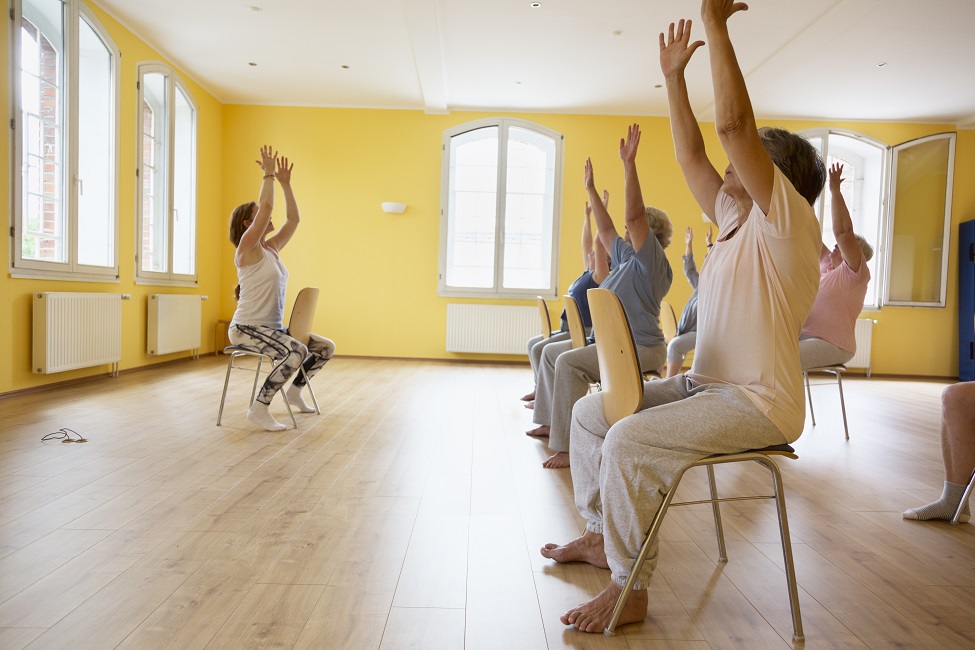Chair Yoga More Effective than Music in Adults with Advanced Dementia

The chair yoga group reported a higher quality of life score, including physical condition, mood, functional abilities, interpersonal relationships, and the ability to participate in meaningful activities.
As dementia progresses, the ability to participate in exercise programs declines. Sticking to a program also becomes challenging because of impaired cognition, mobility issues or risk of falls and fractures – some exercise regimens are just too complicated or physically demanding. Although studies have shown the benefits of physical activity on dementia, few have included participants with moderate-to-severe dementia or examined the effects of gentle types of exercise on this population.
Researchers from Florida Atlantic University conducted a pilot study that is the first cluster, randomized controlled trial to examine the effects of chair yoga on older adults with moderate-to-severe dementia who are unable to participate in regular exercise or standing yoga due to cognitive impairment, problems with balance, or fear of falling. The key aim of the study was to assess the likelihood of these individuals’ ability to participate in non-pharmacological interventions as well as demonstrate the safety and effects of chair yoga on older adults with all levels of dementia.
For the study, published in the American Journal of Alzheimer’s Disease & Other Dementias , researchers compared chair yoga with two other types of non-pharmacological interventions: chair-based exercise and music intervention. Participants in each of the three groups attended 45-minute sessions twice a week for 12 weeks. Researchers collected data at baseline, after six weeks and after completing the 12-week intervention.
Results showed that participants with moderate-to-severe dementia could safely adhere to non-pharmacological interventions. More than 97 percent of the participants fully engaged in each session. Study findings showed that the chair yoga group improved significantly in quality of life compared to the music intervention group. Both the chair yoga and chair-exercise groups showed improvement over time, while the music intervention group declined. In addition, both the chair yoga and chair-based exercise groups showed lower depression across all three time points when compared to the music intervention group.
Researchers examined the effects of chair yoga on physical function, including balance and mobility, and compared the effects with chair-based exercise and music intervention. They also looked at the effects of chair yoga on reducing psychological symptoms like anxiety and depression, behavioral symptoms like agitation or aggression, and improved quality of life. They also explored the effects of chair yoga on sleep problems.
Chair yoga provides a safe environment for stretching, strengthening and flexibility while decreasing the risk of falls by using a chair. It also provides important breathing and relaxation techniques utilizing stationary poses that use isometric contraction and guided relaxation of various muscle groups.
“We think that the physical poses we used in the chair yoga and chair-based exercise groups were an important factor in improving quality of life for the participants in our study,” said Juyoung Park, Ph.D., lead author and an associate professor in the Phyllis and Harvey Sandler School of Social Work within FAU’s College for Design and Social Inquiry. “It is fascinating that, although some participants showed mild levels of agitation or wandering in the intervention room prior to the yoga session, they became calm and attentive when the yoga interventionist started demonstrating yoga poses. Although they did not understand the interventionist’s verbal instructions due to their cognitive impairment associated with advanced dementia, they followed the instructor’s poses.”
Park and collaborators did not find any differences in the three intervention groups on physical function, with the exception of handgrip strength, which was higher in the chair yoga group compared to the music intervention group. None of the three groups declined significantly in any of the investigated physical functional measures.
Researchers also did not find any significant between-group differences in anxiety at any time point. There were no significant between-group differences in change in depression and anxiety. The researchers also did not find significant differences among the three intervention groups for sleep quality at any of the three time points.
“We did see an increase in agitation in the chair yoga group even though this group reported a higher quality of life score, including physical condition, mood, functional abilities, interpersonal relationships, ability to participate in meaningful activities, and final situations,” said Park. “It’s important to note that quality of life is a more comprehensive approach to biopsychosocial and behavioral function than a mere measure of agitation. Meditation and the mind–body connection component of the chair yoga program may have increased quality of life for participants in this study. This finding is consistent with our earlier studies that showed a targeted approach was successful in increasing quality of life in patients with dementia.”
Study participants were 60 years or older (mean average age was 84 years-old) and diagnosed with dementia including Alzheimer’s disease (the largest diagnostic group), Lewy Body dementia and Parkinson disease dementia. There were no significant demographic differences among intervention groups. More than half of the group (67.7 percent) were taking medication(s) to manage symptoms associated with dementia.
Co-authors of the study are James E. Galvin, M.D., M.P.H., director and founder of FAU’s Comprehensive Center for Brain Health (CCBH); Magdalena I. Tolea, Ph.D., a research assistant professor in FAU’s Schmidt College of Medicine and a data manager and analyst in the CCBH; Diane Sherman, Ph.D., a professor in FAU’s Phyllis and Harvey Sandler School of Social Work; Amie Rosenfeld, DPT, in FAU’s Schmidt College of Medicine and a physical therapist in the CCBH; Victoria Arcay, MSW, a social worker at VITAS HealthCare; and Yve Lopes, a social worker.
This research was supported by FAU’s Division of Research through a pilot grant.-FAU-
Tags: faculty and staff | cdsi | research | medicine